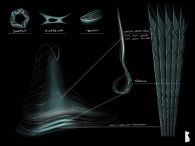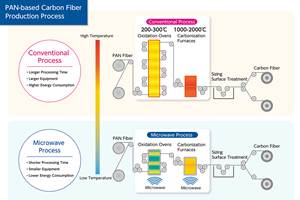The democratization of composites
China as springboard to push adoption of thermoplastic composites and revolutionize consumer goods.
I’ve blogged about Covestro’s Maezio Continuous Fiber-Reinforced Thermoplastic (CFRTP) materials and their application in Haier’s high-end, Casarte air conditioners. Maezio is now being used in the shank of limited-edition running shoes for the Chinese sportswear brand Bmai.
“Covestro has had a global headquarters in Shanghai since 2011,” says David Hartmann, Covestro senior VP growth ventures who resides in Shanghai. “After the global recession, we realized that China was the largest single market for our products, and as such, it would not be possible to develop our business here while maintaining a headquarters only in Europe.” Thus, he explains, Covestro has its well-established bases in Germany and the US, but the center of gravity for Maezio thermoplastic composites is very strongly in Asia.
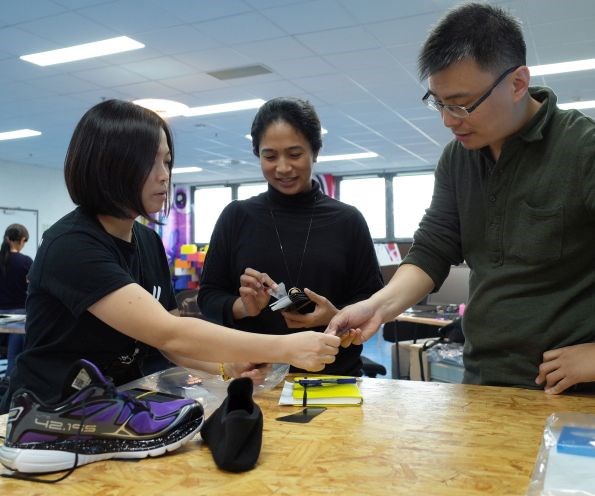
Bmai lead designer Axis Liu works with Covestro team members at Covestro’s APAC Innovation Experience Center in Shanghai. SOURCE | Covestro.
China first
“We see that the most cutting edge and exciting development for consumer goods is in China,” Hartmann continues. “One reason for this is that Chinese consumers are very forgiving. They are willing to try new technology and then move on to the next iteration. If you can keep up with the iteration speed, then it’s easy to come up with new opportunities.”
Although partnerships and working all along the supply chain have always been key for materials suppliers — at DuPont, we worked with our direct Nomex paper customers, the core manufacturers, as well as panel fabricators and Boeing/Airbus — Covestro’s approach in China is a step forward. “In our partnership with Bmai, we were discussing and sending design information back and forth 2-3 times per day through digital communication apps. And it is important to message not just where you succeed, but also where you fail. This is very atypical to what is standard in Europe and the US.”
Another atypical approach is sampling the Chinese market directly through Alibaba’s 1688.com platform, the largest business-to-business digital marketplace in China. “This isn’t only a sales outlet,” says Hartmann. “We are making our products more accessible, which makes it easier for customers to test out the material and helps drive the adoption of thermoplastic composites.” A 1-kg/33-m spool of 120-mm-wide unidirectional carbon fiber/polycarbonate tape is offered for 488 Yuan. Though this is the only Maezio product on 1688.com, Covestro has also commercialized sheets in tailor-made sizes and tapes in widths of 120-730mm, as well as 3k woven alternatives.
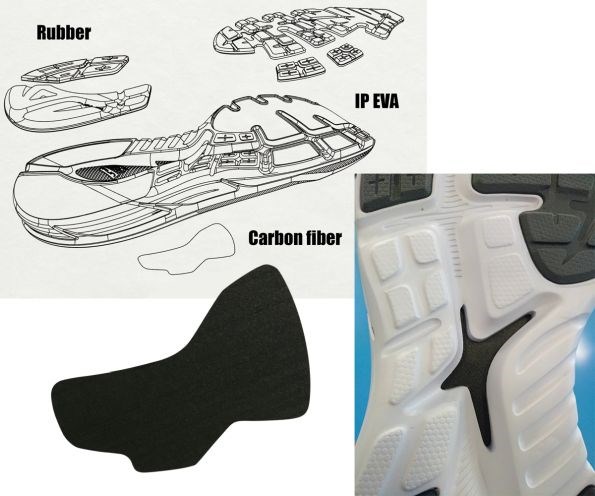
Shank in the limited edition of the Bmai marathon shoe, made of Maezio composites.
SOURCE | Covestro.
Performance for everyone
One reason for this new level of partnering is that composites are so tailorable — or, as Covestro prefers, tunable. “When we make a midsole, we precisely tune the stiffness in one direction and the flexibility in another,” says Hartmann. “For every customer/partner we are working with in shoes — and there are a number of them — we are engineering a slightly different performance envelope based on what they want that shoe to achieve. With thermoplastic composites, you can do this on a large scale.”
He notes that Covestro has been in shoes for a very long time with a variety of materials, and that thermoset composites go back to the 1980s. “Nike was using them in shanks and soles, but they were mostly there for looks,” Harmann recalls. “And then came the Nike Vaporfly 4%, where they designed a shoe to help break the 2-hr marathon barrier. In running, there is nothing between you and the road except the shoe. Nike claimed their use of composites and other technology in that shoe returned 4% of the runner’s energy back to him or her. They now have enough data to show that runners in this shoe are getting up to a 4% advantage.”
But Bmai and Covestro don’t want to help just elite athletes access this type of performance advantage. “This is where Bmai and our group at Maezio connect,” says Hartmann. “Bmai is an unusual company,” adds Covestro global product expert Cholthee Chandrachoti. “They spun off from the top athletic brand in China but set themselves up almost as counter-culture. (NOTE: Bmai translated into English means “be yourself”.) They are located in the middle of Beijing’s largest recreational park and each employee has a running goal. They are super committed to making athletic performance open to everyone, emphasizing that everyone has a right to help themselves to run faster and achieve their best.” She adds that in China there are now more than 1,000 marathons each year.
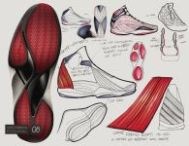 |
Sketches from shoe designer Brett Golliff show the complex functionality being sought in both designs and materials (see carbon fiber in center image), as well as a glimpse into how different shoes may be in the future, at right.
SOURCE| Coroflot.com (left, center) and (right) originally from Complex.com (no longer available) but currently posting at Sohu.com and museafrica.com.
Changing traditional consumer applications
This idea of democratizing athletic performance is intriguing. “We have already received requests from customers regarding solutions designed for women, such as higher-performance high heels,” says Chandrachoti. “They need flexibility for the forefoot but more rigidity in the arch and then even more support as you move to the heel. However, the manufacturers do not want a lot of different materials and parts to assemble. They want one part. We can enable this with Maezio.”
Hartmann lists a variety of potential shoe components including midsoles, toe caps, uppers and outsoles. “The midsole is between the cushion on top and the outer sole,” he explains. “Shoe designers are trying to find a very dense material to support the shoe but also contribute functions like cushion and durability.” Chandrachoti adds pronation as another key function, which affects orthopedic health, stability and control during exercise. Pronation is the side-to-side movement of the foot while walking or running. If you overpronate — i.e., your foot rolls inward more than normal — then your shoe should help distribute impact evenly and add stability. If you underpronate — i.e., your foot rolls inward less than normal — then your shoe should provide more cushioning to absorb the extra vertical force and impact. “Shoe manufacturers want to increase the stiffness, cushioning and/or flexibility for a specific action or profile of use,” she explains. “This tunability has been limited by conventional materials and the weight of these materials also needs to be reduced. Thermoplastic composites offer a solution to both issues.”
Maezio material samples for shoe toecap, shank and midsole. SOURCE | Covestro.
This was Bmai’s first foray into thermoplastic composite materials and a kind of test case. “Their goal is to keep the price affordable. Bmai does not have a lot of retail stores — 70% of their sales are online. The few stores they do have are called ‘experience centers’ and offer education for customers about their products.” Because Bmai doesn’t spend a lot of money on ads or big-ticket marketing, the average price for a pair of their shoes is below $100.
Matrix options and sustainability
Polycarbonate (PC) is the first material commercialized for Maezio products because Covestro has extensive expertise and capacity here. “The solution for Bmai was PC, but we are screening a range of materials for shoes,” says Chandrachoti. “We have ten different materials in testing, including thermoplastic polyurethane (TPU).”
Regarding recyclability, Hartmann says that by 2024, the EU wants to ban single-use plastics. “We have recycled grades of PC on the market already, and are looking at it for Maezio, but we need initial partners who want to develop this. We cannot do it alone because it involves the whole value chain.” He asserts that thermoplastic composites have the potential to be more sustainable than thermosets because scrap is chipped and remolded or turned into injection molding compounds. “Closed-loop recycling for Maezio would require building a dedicated value chain,” Hartmann points out. “But we have done exactly that in our work with Haier. Over eight months, our technical team accessed a large number of partners in China to make that program work. But that kind of partnership and sustainability are the future for both the chemicals and composites industries.”
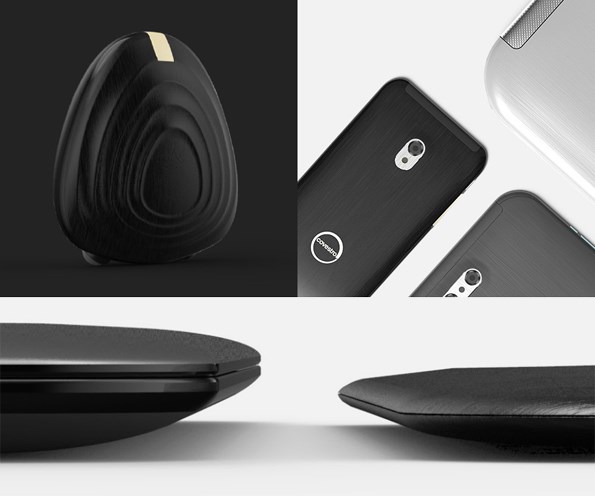
Maezio continuous fiber thermoplastic composites enable lighter, thinner and complex-shaped consumer electronics with production volumes totaling millions of parts/yr.
SOURCE | Covestro.
Other applications and industries
Hartmann sees Maezio as providing lightweight solutions for a broad range of applications. “We have a number of active commercial automotive programs underway and are currently talking to most major laptop manufacturers.” He says the laptop industry wants “thinner and lighter”, yet the outer cover must be stiff enough to protect the electronics. Manufacturers have traditionally used magnesium alloys for the outer surface of commercial laptops, but there have been supply chain issues and Maezio offers some interesting design flexibility including various surface finishes.
Battery packs and luggage are other applications in development. “For luggage, our material has a unique aesthetic as well as functionality and lightweight,” says Hartmann. “And we have managed to solve the issues with forming deep-draw structures. The corners – called suitcase corners -- are quite difficult. When we achieved these, we really felt a sense of accomplishment and also showed our ability to meet the industry’s needs.” This formability is also helping Maezio’s development in bikes and other sporting goods.
… the meaning of “Made in China” is changing. There is a fetish of design here … coupled with a desire for democratization. The goal is that everyone should have access to style and performance.
High performance, high volume, low price?
It is interesting that all of Maezio’s current development programs are for consumer goods produced at relatively high volumes. “For small parts like a shoe insole or laptop cover, you are looking at annual volumes in the millions,” says Hartmann. “This is where the advantages of thermoplastic composites come into play. With thermosets, this volume was very difficult. With our materials, it isn’t an issue.” Why not? Because of the fast molding cycles possible, typically measured in 1-2 minutes, down to seconds. “Still, being a new startup, we feel that our job is to learn about these industries and markets to better understand what they need, and what we must do to meet their requirements.”
Hartmann says the meaning of “Made in China” is changing. “There is a fetish of design here that is very strong, but it is coupled with a desire for democratization. The goal is that everyone should have access to style and performance.” He cites the Chinese electronics manufacturer Xiaomi as a good example. “They are known for producing high-quality electronics, but at a lower price,” he explains. “They have committed to taking only a 5% profit margin and aim for a large customer population. With Maezio, Covestro CFRTP is in step with this market and product evolution. We are allowing people to experience the design, performance and lifestyle advantages that composites have to offer — but without a Lamborghini pricetag.”
Related Content
Novel composite technology replaces welded joints in tubular structures
The Tree Composites TC-joint replaces traditional welding in jacket foundations for offshore wind turbine generator applications, advancing the world’s quest for fast, sustainable energy deployment.
Read MoreMicrowave heating for more sustainable carbon fiber
Skeptics say it won’t work — Osaka-based Microwave Chemical Co. says it already has — and continues to advance its simulation-based technology to slash energy use and emissions in manufacturing.
Read MoreNatural fiber composites: Growing to fit sustainability needs
Led by global and industry-wide sustainability goals, commercial interest in flax and hemp fiber-reinforced composites grows into higher-performance, higher-volume applications.
Read MoreWatch: A practical view of sustainability in composites product development
Markus Beer of Forward Engineering addresses definitions of sustainability, how to approach sustainability goals, the role of life cycle analysis (LCA) and social, environmental and governmental driving forces. Watch his “CW Tech Days: Sustainability” presentation.
Read MoreRead Next
Plant tour: Daher Shap’in TechCenter and composites production plant, Saint-Aignan-de-Grandlieu, France
Co-located R&D and production advance OOA thermosets, thermoplastics, welding, recycling and digital technologies for faster processing and certification of lighter, more sustainable composites.
Read MoreVIDEO: High-volume processing for fiberglass components
Cannon Ergos, a company specializing in high-ton presses and equipment for composites fabrication and plastics processing, displayed automotive and industrial components at CAMX 2024.
Read MoreDeveloping bonded composite repair for ships, offshore units
Bureau Veritas and industry partners issue guidelines and pave the way for certification via StrengthBond Offshore project.
Read More








